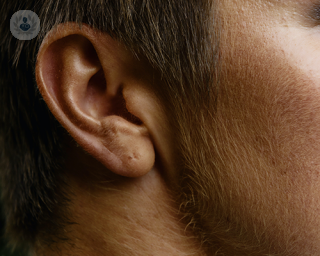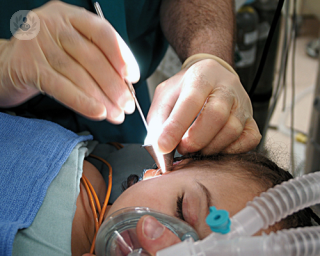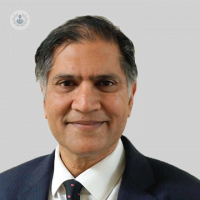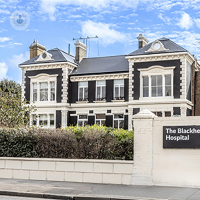Middle ear surgery
Mr Michael Pringle - Otolaryngology / ENT
Created on: 11-13-2012
Updated on: 05-03-2023
Edited by: Karolyn Judge
What is middle ear surgery?
Middle ear surgery is a series of surgical interventions to treat problems in the tympanic membrane, in the chain of tiny interconnected bones (the hammer, anvil and stirrup) and in the mastoid cells (cavities of the temporal bone).
There are two major surgical procedures: tympanoplasty and mastoidectomy. Tympanoplasty involves ossiculoplasty (repairing the bones) and myringoplasty (closing a hole in the eardrum).

Why is middle ear surgery performed?
Middle ear surgery is recommended for treating middle ear problems. Tympanoplasty is recommended for large eardrum perforations or middle ear infections such as acute or chronic otitis media that cannot be cured with antibiotics.
Mastoidectomy is an operation to remove the flat air cavities of the skull behind the ear (temporal bone) in order to treat infections of the mastoid portion in that part of the skull, to treat complications of otitis media, abnormal bone growth, cholesteatoma (skin cell cyst in the middle ear), or to place cochlear implants.
What does middle ear surgery involve?
In middle ear surgery, The middle ear is accessed through a cut behind the ear or through the ear canal so that the appropriate procedures can be performed, depending on the injury. The procedure may involve removing any infection or dead tissue in the eardrum, placing a graft to reconstruct the tympanic membrane, or placing a prosthesis to replace a damaged bone.
What's involved in the preparation for middle ear surgery?
Before middle ear surgery, the specialist, or otorhinolaryngologist, will check to make sure you don’t have an ear infection. This will require several tests, including an ear examination and a hearing test. In some cases, a CT scan of the head may also be needed.
You must also consult your doctor about medication you can or cannot take. For example, you may need to stop taking certain drugs such as aspirin, anti-inflammatories or blood thinners a week prior to surgery.
What's involved in post-middle ear surgery after care?
To ensure proper recovery after middle ear surgery, you should avoid:
- Sneezing too hard, or holding in a sneeze;
- Getting water in your ear for 1 - 3 months - taking a bath is advised over having a shower, and you should wait until the packing is removed;
- Flying;
- Swimming or diving;
- Lifting weights and excess tension;
You will have to wait a few weeks after the operation to know whether your middle ear surgery has been successful or not. Full recovery from middle ear surgery will take approximately four weeks if the post-operative care guidelines have been followed according to your specialist's recommendations.















